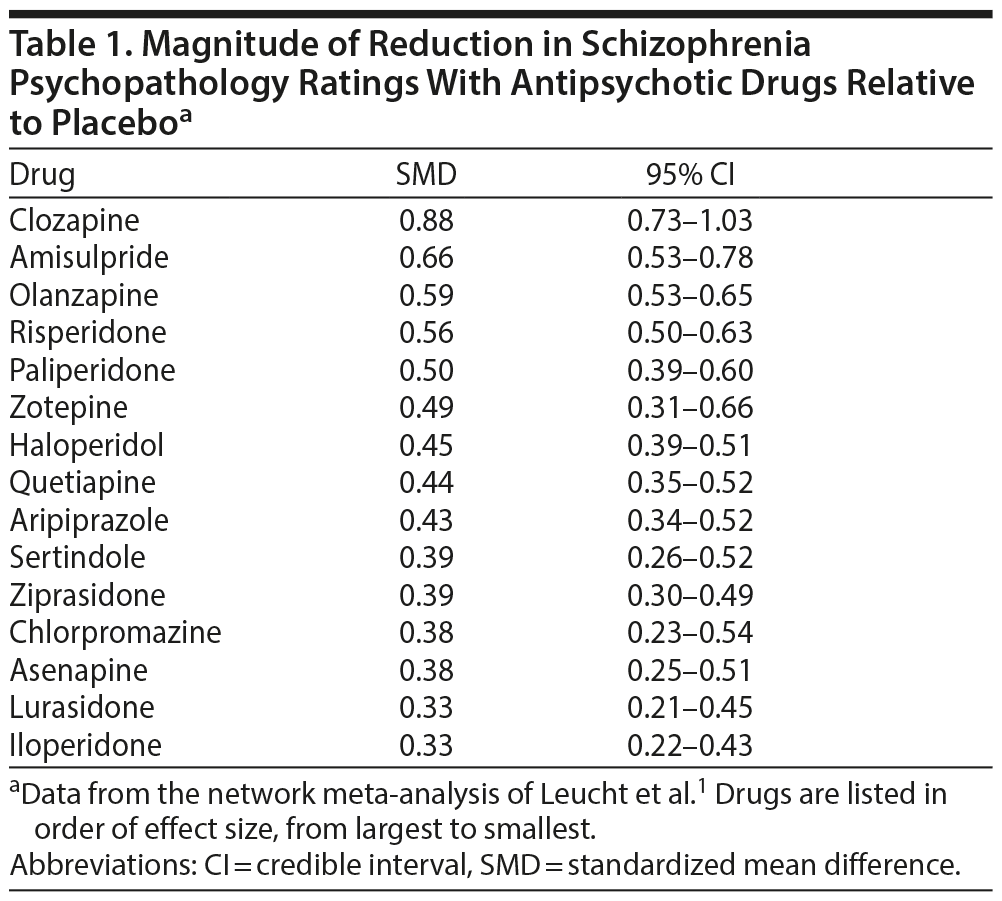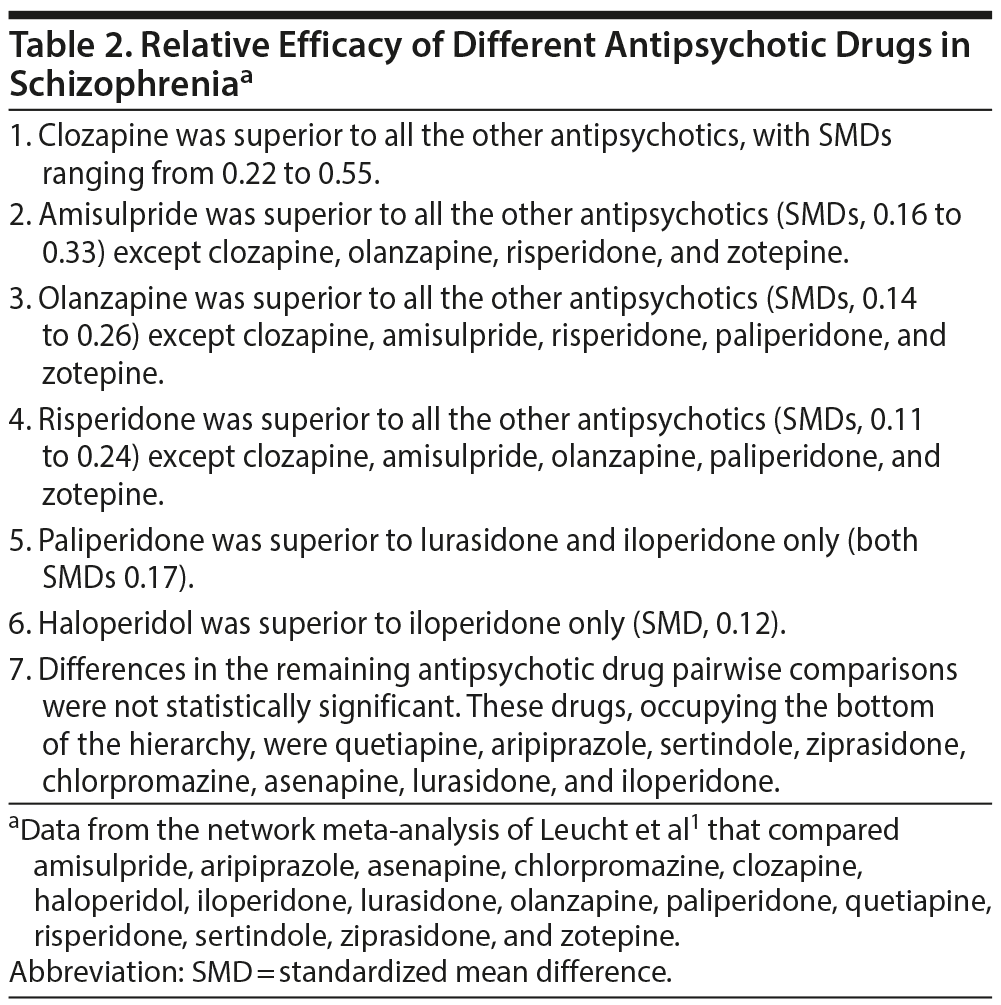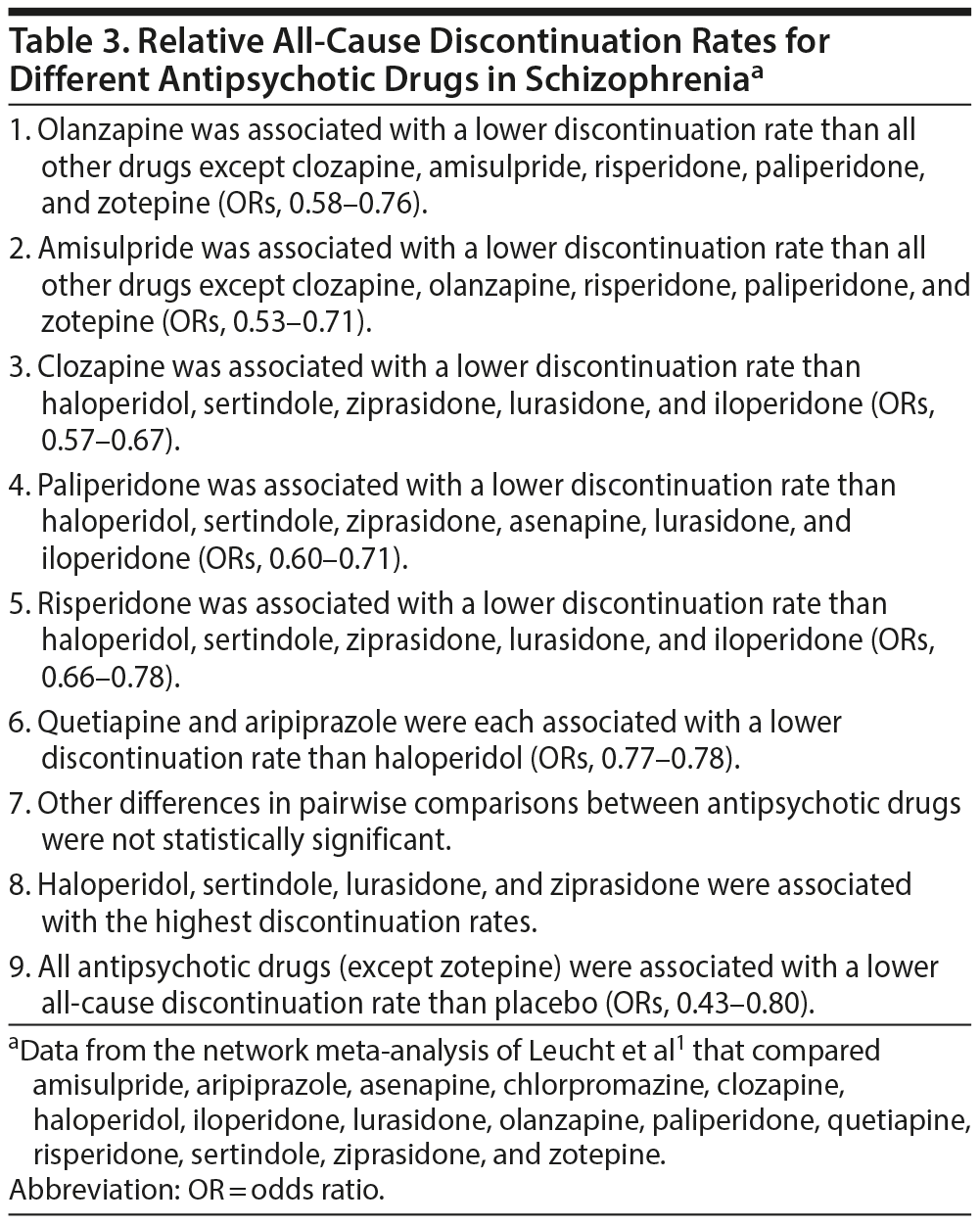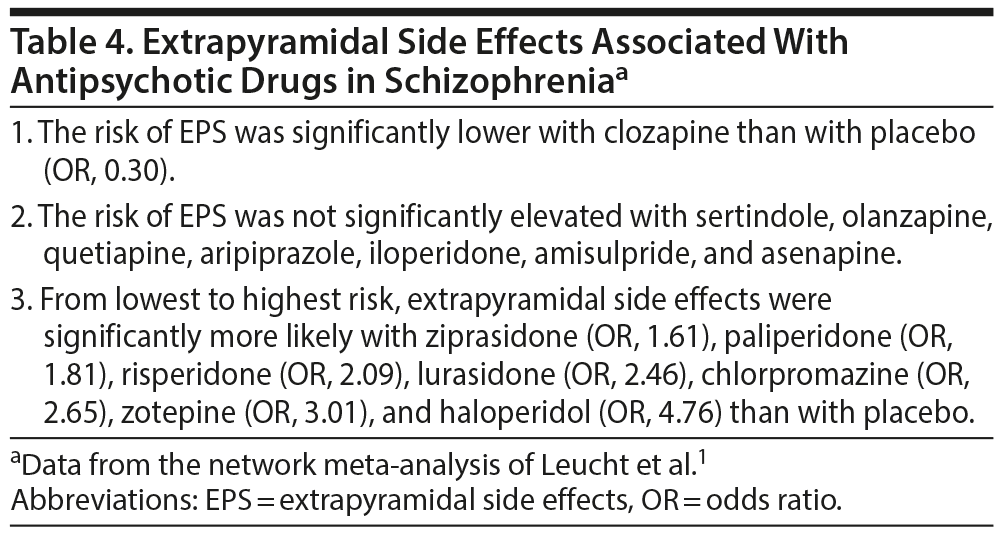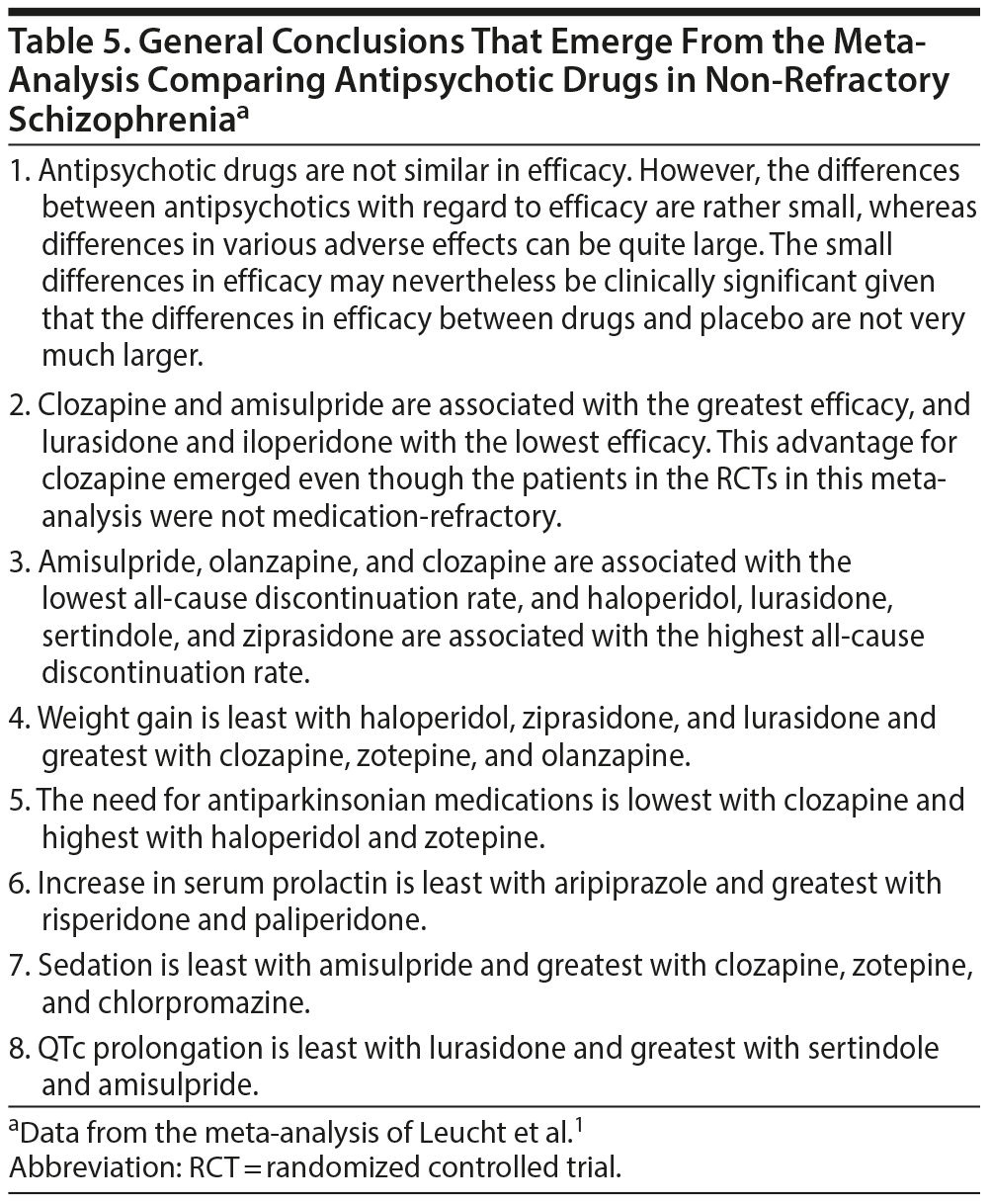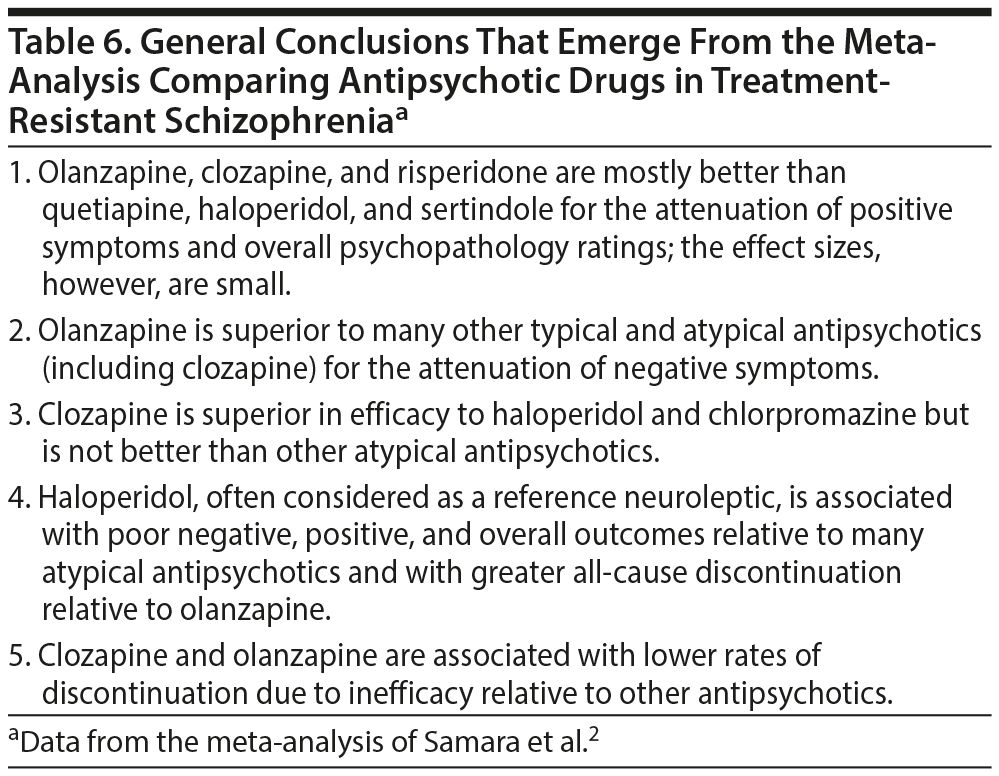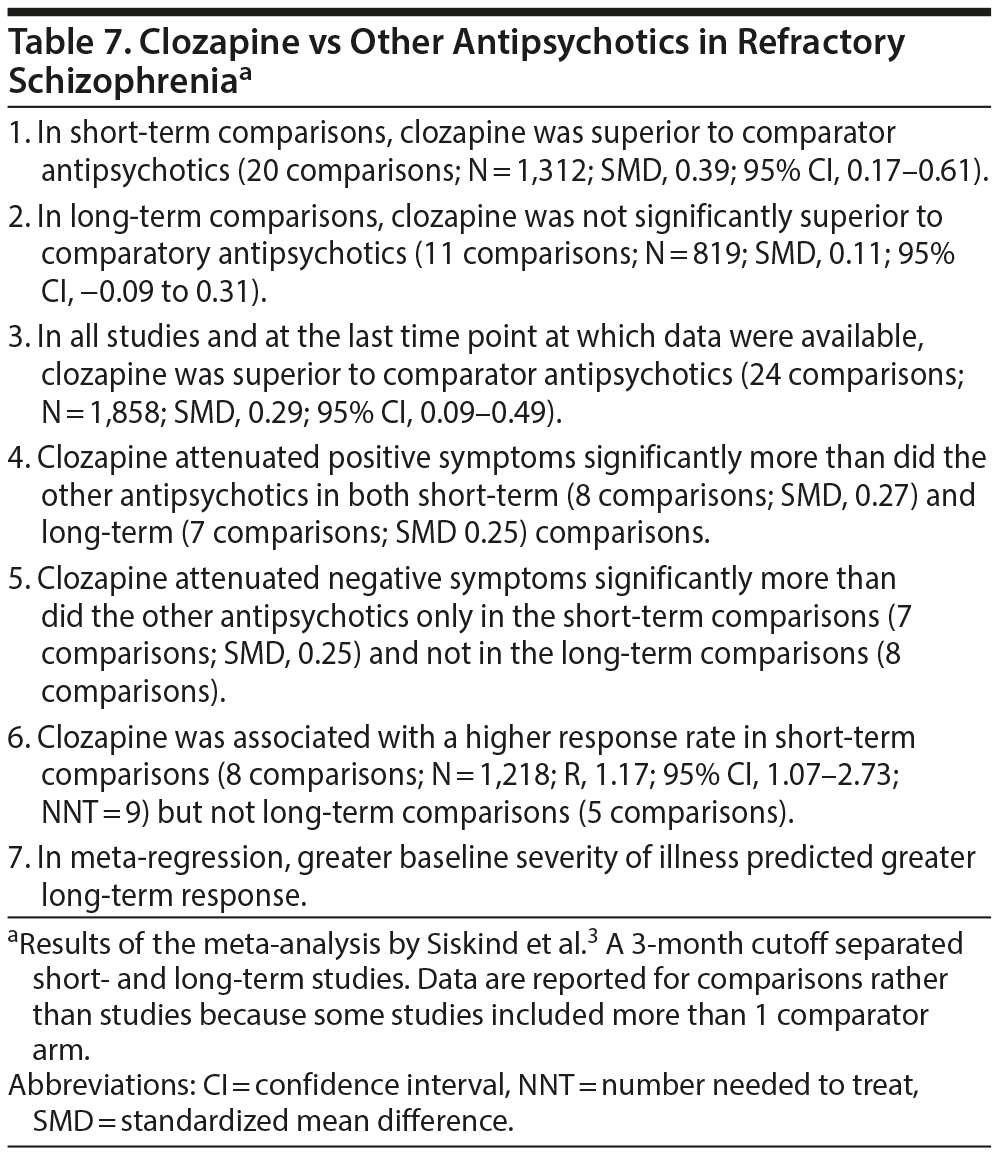How antipsychotic drugs compare in schizophrenia, and especially in medication-refractory schizophrenia, is a subject of considerable interest. Two network meta-analyses and 1 direct comparison meta-analysis recently compared antipsychotics in schizophrenia patients with and without documented treatment resistance. One network meta-analysis of antipsychotic drugs in non-refractory patients found clear efficacy advantages for clozapine, amisulpride, olanzapine, and risperidone. One network meta-analysis of antipsychotic drugs in refractory patients found a clear efficacy advantage for olanzapine; surprisingly, in this meta-analysis, clozapine was superior to first-generation but not second-generation antipsychotics. One direct comparison meta-analysis found clozapine generally superior to first- and second-generation antipsychotics, with advantages more clearly apparent in studies that were 3 months in duration or less. Drug discontinuation and adverse effect data from these meta-analyses are presented, and issues arising from the results are briefly discussed. At the risk of oversimplification, it appears that clozapine retains its preeminence in medication-refractory schizophrenia and that clozapine and olanzapine are both associated with superior efficacy outcomes in non-refractory patients. Interestingly, haloperidol, generally considered a reference neuroleptic and a reference comparator drug, fared poorly in most comparisons.
- In schizophrenia patients who are not refractory to medications, clozapine and amisulpride are associated with the best efficacy outcomes. However, olanzapine and risperidone are also associated with more favorable efficacy outcomes than many other antipsychotic drugs.
- Clozapine and olanzapine are associated with the best efficacy outcomes in medication-refractory schizophrenia.
- Haloperidol is associated with poorer outcomes than many other antipsychotic drugs in both non-refractory and refractory schizophrenia.

ABSTRACT
How antipsychotic drugs compare in schizophrenia, and especially in medication-refractory schizophrenia, is a subject of considerable interest. Two network meta-analyses and 1 direct comparison meta-analysis recently compared antipsychotics in schizophrenia patients with and without documented treatment resistance. One network meta-analysis of antipsychotic drugs in non-refractory patients found clear efficacy advantages for clozapine, amisulpride, olanzapine, and risperidone. One network meta-analysis of antipsychotic drugs in refractory patients found a clear efficacy advantage for olanzapine; surprisingly, in this meta-analysis, clozapine was superior to first-generation but not second-generation antipsychotics. One direct comparison meta-analysis found clozapine generally superior to first- and second-generation antipsychotics, with advantages more clearly apparent in studies that were 3 months in duration or less. Drug discontinuation and adverse effect data from these meta-analyses are presented, and issues arising from the results are briefly discussed. At the risk of oversimplification, it appears that clozapine retains its preeminence in medication-refractory schizophrenia and that clozapine and olanzapine are both associated with superior efficacy outcomes in non-refractory patients. Interestingly, haloperidol, generally considered a reference neuroleptic and a reference comparator drug, fared poorly in most comparisons.
J Clin Psychiatry 2016;77(12):e1656-e1660
dx.doi.org/10.4088/JCP.16f11328
© Copyright 2016 Physicians Postgraduate Press, Inc.
Introduction
A large number of typical and atypical antipsychotics are available around the world, offering psychiatrists a choice of plenty for the treatment of schizophrenia. How do these drugs compare in their efficacy and adverse effect profile? Three recent meta-analyses1-3 addressed the subject from different angles. These meta-analyses are rather detailed and contain some unexpected findings. The present article therefore summarizes the findings of these meta-analyses and offers the reader a critical perspective.
A Comparison of Antipsychotic Drugs in Non-Refractory Schizophrenia
Leucht et al1 described a Bayesian-framework, multiple-treatments meta-analysis that utilized both direct and indirect comparisons to create a hierarchy for efficacy (based on psychopathology ratings) along with 6 other outcome measures. The authors searched computerized databases and other sources and identified 212 placebo-controlled, short-term (4-12 weeks), blinded randomized controlled trials (RCTs) (pooled N = 43,049) of 15 antipsychotic drugs administered as monotherapy in acute schizophrenia, schizoaffective disorder, schizophreniform disorder, and related psychotic conditions, as diagnosed using any criteria. Trials were excluded if they were conducted in stable patients, in those with predominantly negative symptoms, in those with concurrent medical illness, and in those with refractory illness.
The largest quantity of data was available for haloperidol, olanzapine, and risperidone. The mean age of the patients in the RCTs was about 38 years, and the mean duration of illness was about 12 years. Two-thirds (n = 144) of the studies were industry-driven. Only 9 studies were conducted in first-episode patients.
Psychopathology ratings. All 15 antipsychotic drugs outperformed placebo on the Positive and Negative Syndrome Scale (PANSS) or Brief Psychiatric Rating Scale. The effect size was large for clozapine (standardized mean difference [SMD], 0.88); intermediate for amisulpride, olanzapine, risperidone, and paliperidone (SMDs between 0.50 and 0.66); and small for zotepine, haloperidol, quetiapine, aripiprazole, sertindole, ziprasidone, chlorpromazine, asenapine, lurasidone, and iloperidone (SMDs between 0.33 and 0.49) (Table 1). The number needed to treat (NNT) favoring medication ranged from 6 with amisulpride to 20 with haloperidol.
The network meta-analysis identified substantial differences in efficacy between the different drugs. Clozapine emerged as the best antipsychotic in the hierarchy, followed by amisulpride, olanzapine, and risperidone (Table 2).
Drug discontinuation. The overall all-cause discontinuation rate was 35%. Among patients who discontinued treatment, the commonest reason for discontinuation was treatment inefficacy (40%). Adverse events were responsible for only 17% of dropouts. Olanzapine, amisulpride, and clozapine were associated with the most favorable all-cause discontinuation profiles. Importantly, almost all antipsychotic drugs were associated with a lower all cause discontinuation rate than placebo (Table 3).
Weight gain. All antipsychotics were associated with significant weight gain relative to placebo, except for haloperidol, ziprasidone, and lurasidone; iloperidone, clozapine, zotepine, and olanzapine were associated with the greatest weight gain (SMDs, 0.62 to 0.74). These data were summarized in an earlier article in this column and are therefore not repeated here.4
Extrapyramidal adverse effects. The risk of extrapyramidal adverse effects, as compared with placebo, and operationalized by the use of antiparkinsonian drugs, was lowest with clozapine (odds ratio [OR], 0.30) and highest with haloperidol (OR, 4.76) (Table 4).
Sedation. Amisulpride, paliperidone, sertindole, and iloperidone were not associated with statistically significant sedation, although the ORs and especially the 95% confidence intervals (CIs) did imply likelihood of risk. There was significant risk of sedation with the remaining drugs in the following order of lowest to highest: aripiprazole (OR, 1.84), lurasidone (OR, 2.45), risperidone (OR, 2.45), haloperidol (OR, 2.76), asenapine (OR, 3.28), olanzapine (OR, 3.34), quetiapine (OR, 3.76), ziprasidone (OR, 3.80), chlorpromazine (OR, 7.56), zotepine (OR, 8.15), and clozapine (OR, 8.82).
Serum prolactin elevation. No drug significantly lowered serum prolactin; the benefits of aripiprazole, in this regard, narrowly missed statistical significance (SMD, −0.22). Relative to placebo, increase in serum prolactin was not statistically significant for quetiapine, asenapine, chlorpromazine, and iloperidone. Seven antipsychotics significantly raised serum prolactin; from least increase to greatest increase, these were olanzapine (SMD, 0.16), ziprasidone (SMD, 0.25), lurasidone (SMD, 0.34), sertindole (SMD, 0.45), haloperidol (SMD, 0.70), risperidone (SMD, 1.23), and paliperidone (SMD, 1.30). No RCT included in the meta-analysis provided data for clozapine, amisulpride, and zotepine comparisons. However, there is adequate evidence from outside this meta-analysis documenting increase in serum prolactin levels with amisulpride and zotepine and absence of increase with clozapine. Importantly, paliperidone and risperidone raised serum prolactin significantly more than did all other drugs, including haloperidol, and haloperidol increased serum prolactin significantly more than all the remaining drugs except chlorpromazine and sertindole.
QTc prolongation. QTc prolongation was not statistically significant for lurasidone, aripiprazole, paliperidone, and asenapine. QTc decrease with lurasidone and increase with asenapine narrowly missed statistical significance. There was a significant increase in QTc with the remaining drugs. Listed in increasing order, these were haloperidol (SMD, 0.11), quetiapine (SMD, 0.17), olanzapine (SMD, 0.22), risperidone (SMD, 0.25), iloperidone (SMD, 0.34), ziprasidone (SMD, 0.41), amisulpride (SMD, 0.66), and sertindole (SMD, 0.90). In these RCTs, QTc data were unavailable for clozapine, chlorpromazine, and zotepine.
Other issues. Meta-regression analyses were provided in the supplemental data. These showed, for example, that chlorpromazine doses above 600 mg/d were associated with greater efficacy without a corresponding increase in extrapyramidal side effects. In contrast, haloperidol doses below 12 mg/d (and even 7.5 mg/d) reduced extrapyramidal side effects without compromising efficacy.
Inconsistencies between direct and indirect estimates were few and did not influence the general results. The results were generally unchanged in the different sensitivity analyses conducted. The efficacy outcomes remained largely similar in analyses that removed the placebo or haloperidol groups and when dose, discontinuation rate, blinding, industry support, study duration, illness chronicity, and year of publication were examined in meta-regressions and sensitivity analyses. The overall findings of the meta-analysis are summarized in Table 5.
A Comparison of Antipsychotic Drugs in Refractory Schizophrenia
Samara et al2 described a Bayesian-framework, network meta-analysis that utilized both direct and indirect comparisons of antipsychotic medications in patients with treatment-resistant schizophrenia. The authors searched computerized databases and other sources and identified 40 single- or double-blind RCTs (pooled N = 5,172) of 12 antipsychotic drugs administered as monotherapy.
The mean age of the pooled sample was about 39 years; the sample was 72% male. The mean duration of illness was about 16 years. Patients had had a mean of 7 previous hospitalizations. All RCTs were at least 3 weeks long; the median duration was 11 weeks. The mean dropout rate was 30%. Clozapine was represented in 20 RCTs, haloperidol in 15, olanzapine in 14, and risperidone in 12. Data for aripiprazole, perphenazine, and thiothixene could not be included because the data were not usable or were not connected to the network.
Efficacy. There were 9 antipsychotic drugs included in the network meta-analysis of psychopathology ratings; these were chlorpromazine, clozapine, fluphenazine, haloperidol, olanzapine, quetiapine, risperidone, sertindole, and ziprasidone. Olanzapine was superior to quetiapine, haloperidol, and sertindole (SMDs, 0.29 to 0.46, corresponding to 6-10 PANSS points); clozapine was superior to haloperidol and sertindole (SMDs, 0.22 to 0.40, corresponding to 5-8 PANSS points); and risperidone was superior to sertindole (SMD, 0.32, corresponding to 7 PANSS points). There were no significant differences in other comparisons between antipsychotics. Haloperidol, fluphenazine, and sertindole were lowest in the efficacy hierarchy.
In this network meta-analysis,2 olanzapine, clozapine, and risperidone were superior to quetiapine for the attenuation of positive symptoms (SMDs, 0.33 to 0.43, corresponding to 2-3 PANSS points), and clozapine and risperidone were superior to haloperidol (SMDs, 0.27 to 0.29, corresponding to about 2 PANSS points). Olanzapine was superior to clozapine, risperidone, haloperidol, chlorpromazine, and sertindole for the attenuation of negative symptoms; the SMDs ranged from 0.14 to 0.44, corresponding to about 1.0 to 2.5 PANSS points. Ziprasidone was superior to both chlorpromazine and sertindole (SMDs, 0.26 to 0.44).
Risperidone, clozapine, and olanzapine were each associated with about doubled odds of treatment response relative to haloperidol; the corresponding NNTs were 7 to 8. Otherwise, there were no significant differences in the response rates in pairwise comparisons in the network meta-analysis.
Drug discontinuation. Olanzapine significantly reduced the odds of all-cause discontinuation relative to haloperidol (OR, 0.56) and fluphenazine (OR, 0.24); otherwise, the network meta-analysis found no significant differences in pairwise comparisons between antipsychotic drugs. Discontinuation due to inefficacy was significantly less likely with clozapine than with fluphenazine, haloperidol, quetiapine, and risperidone (ORs, 0.08 to 0.44; NNTs, 6-10), and, for this outcome, chlorpromazine and olanzapine were superior to haloperidol and fluphenazine (ORs, 0.04 to 0.27; NNTs, 5-7), and risperidone was superior to fluphenazine (OR, 0.19; NNT, 7).
A number of subgroup, sensitivity, and meta-regression analyses were conducted, including an inspection of outcomes in the context of varying degrees of treatment resistance; these yielded no fresh insights, perhaps because most of the analyses were underpowered. The findings of this meta-analysis are summarized in Table 6.
Clozapine vs Other Antipsychotics inRefractory Schizophrenia
Siskind et al3 described a conventional meta-analysis of single- or double-blind, direct comparisons of clozapine with first- and second-generation antipsychotics in treatment-refractory schizophrenia. The authors searched computerized databases and other sources and identified 25 comparisons in 21 papers (pooled N = 2,364). The comparator drugs were olanzapine (9 studies), risperidone (7 studies), haloperidol (5 studies), chlorpromazine (2 studies), and quetiapine and ziprasidone (1 study each).
Eight papers described studies that were funded by the manufacturer of the comparator antipsychotic, and 2 papers described studies funded by the manufacturer of clozapine. Data were reported for trial durations ranging from 6 to 78 weeks; with 3 months set as a cutoff, there were 21 short-term and 13 long-term comparisons.
Efficacy outcomes. Important efficacy outcomes are presented in Table 7. In summary, clozapine was superior to comparator antipsychotics for positive symptom outcomes, negative symptom outcomes, and overall psychopathology ratings; the benefits were clearer in the short-term comparisons.
Some interesting findings emerged in sensitivity analyses. The benefits of clozapine on psychopathology ratings were evident in both short- and long-term comparisons when industry-supported studies were excluded. Clozapine was generally underdosed relative to the comparator antipsychotics; when studies with less dosing imbalance were examined, the advantage for clozapine was enhanced. Clozapine was strongly superior to comparator drugs in pediatric trials (3 comparisons).
Excluding studies that included medication-intolerant patients and excluding single-blind studies did not change the findings. Similarly, an examination of clozapine vs first- and second-generation drugs separately did not change the findings. Clozapine was superior to olanzapine, haloperidol, and chlorpromazine in the short term. Clozapine was not superior to olanzapine in the long term and was not superior to risperidone in either short- or long-term comparisons.
Other outcomes. Study completion was comparable in clozapine and comparator groups in both short-term and long-term comparisons. Adverse drug reactions corresponded to the known profile of the drugs.
General Comments
Many antipsychotic drugs were not represented in the meta-analyses. In some cases, such as for brexpiprazole and cariprazine, the probable explanation is that the data were unavailable at the time the meta-analyses were conducted. In some cases, such as for blonanserin, there may have been too few RCTs on the drug published in the English language. With other antipsychotics, such as perphenazine, sulpiride, levosulpiride, pimozide, penfluridol, trifluoperazine, and flupenthixol, the RCTs may not have met the defining criteria set by the authors.
A broad finding from the meta-analysis in non-refractory schizophrenia1 was that amisulpride and olanzapine appeared to offer the best balance between high efficacy and a low all-cause discontinuation rate. Whereas this observation could influence prescribing practices, clinicians must realize that other matters should also be kept in mind, such as sensitivity to prolactin-related adverse effects with amisulpride (not shown in this meta-analysis), risk of sedation and weight gain associated with clozapine and olanzapine (the other 2 drugs that scored heavily on efficacy), and so on. Readers are reminded that most advantages for one antipsychotic over another were characterized by small effect sizes; therefore, at least for some drugs in some patients, it could make sense to consider the potential adverse effect burden as a concern that overrides an efficacy advantage. Individualized, informed decision-making is called for.
It is interesting that many of the more recently introduced antipsychotics (aripiprazole, quetiapine, ziprasidone, asenapine, iloperidone, and lurasidone) were ranked in the lower half of the efficacy hierarchy of treatments for non-refractory schizophrenia.1 Paliperidone was an exception; so, the finding was probably not a cohort effect. Additionally, year of publication of RCT did not influence the results, as examined in a meta-regression analysis.1
Given that many of the newer antipsychotics (lurasidone, risperidone, paliperidone, ziprasidone) were associated with a significant risk of extrapyramidal adverse effects, it is a moot point whether the term atypical antipsychotic can be justifiably applied to these drugs. In support of the designation of atypicality, however, tardive dyskinesia is uncommon with the newer drugs.
The findings of the different meta-analyses cannot be generalized beyond the data from which they were generated. For example, the results of the meta-analysis on non-refractory schizophrenia1 cannot be generalized to youth with schizophrenia, those with first-episode or negative symptom illness, those with significant medical comorbidities or refractory illness, and those with stable illness.
Specific Comments on the Place of Clozapine
Clozapine, globally considered the treatment of choice in patients with medication-refractory schizophrenia, was surprisingly not superior to any of the second-generation antipsychotics in one network meta-analysis of antipsychotic drugs in treatment-resistant schizophrenia.2 This questions the special position that clozapine holds in the treatment of refractory schizophrenia.5
There are many possible explanations. Clozapine may have been underdosed in the included RCTs; dosing was certainly lower in the comparisons with second-generation antipsychotics relative to the comparisons with first-generation antipsychotics. Many important clozapine studies were excluded from this meta-analysis because the clozapine arms were not blinded. Patients who were markedly refractory may have been underrepresented in the RCTs. It must also be considered that clozapine has been associated with special benefits (eg, attenuation of aggression, a lower risk of rehospitalization, and a lower risk of suicide) that would not have been captured in the psychopathology ratings examined in the meta-analysis.5-7 Reassuringly, the more inclusive, direct-comparison meta-analysis of clozapine in refractory schizophrenia clearly identified a preeminent position for this drug with regard to efficacy outcomes.3
Parting Notes
Tables 5, 6, and 7 summarize the findings of the 3 meta-analyses examined in this article. At the risk of extreme oversimplification, it can be considered that clozapine and olanzapine are associated with the best efficacy outcomes in both refractory and non-refractory schizophrenia; clozapine remains a preeminent choice for refractory schizophrenia.
 Each month in his online column, Dr Andrade considers theoretical and practical ideas in clinical psychopharmacology with a view to update the knowledge and skills of medical practitioners who treat patients with psychiatric conditions.
Each month in his online column, Dr Andrade considers theoretical and practical ideas in clinical psychopharmacology with a view to update the knowledge and skills of medical practitioners who treat patients with psychiatric conditions.
Department of Clinical Psychopharmacology and Neurotoxicology, National Institute of Mental Health and Neurosciences, Bangalore, India ([email protected]).
Financial disclosure and more about Dr Andrade.
REFERENCES
1. Leucht S, Cipriani A, Spineli L, et al. Comparative efficacy and tolerability of 15 antipsychotic drugs in schizophrenia: a multiple-treatments meta-analysis. Lancet. 2013;382(9896):951-962. PubMed doi:10.1016/S0140-6736(13)60733-3
2. Samara MT, Dold M, Gianatsi M, et al. Efficacy, acceptability, and tolerability of antipsychotics in treatment-resistant schizophrenia: a network meta-analysis. JAMA Psychiatry. 2016;73(3):199-210. PubMed doi:10.1001/jamapsychiatry.2015.2955
3. Siskind D, McCartney L, Goldschlager R, et al. Clozapine v. first- and second-generation antipsychotics in treatment-refractory schizophrenia: systematic review and meta-analysis. Br J Psychiatry. 2016;209(5):385-392. PubMed doi:10.1192/bjp.bp.115.177261
4. Andrade C. Cardiometabolic risks in schizophrenia and directions for intervention, 1: Magnitude and moderators of the problem. J Clin Psychiatry. 2016;77(7):e844-e847. PubMed doi:10.4088/JCP.16f10997
5. Kane JM, Correll CU. The role of clozapine in treatment-resistant schizophrenia. JAMA Psychiatry. 2016;73(3):187-188. PubMed doi:10.1001/jamapsychiatry.2015.2966
6. Mustafa FA. Use of clozapine in schizophrenia. JAMA Psychiatry. 2016;73(10):1097. PubMed doi:10.1001/jamapsychiatry.2016.0976
7. McEvoy JP. Use of clozapine in schizophrenia. JAMA Psychiatry. 2016;73(10):1097-1098. PubMed doi:10.1001/jamapsychiatry.2016.1241
Save
Cite
Advertisement
GAM ID: sidebar-top
